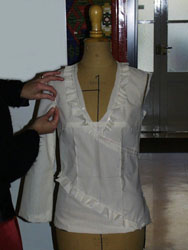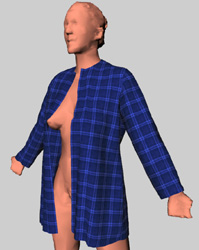
|
|
ERCIM News No.46, July 2001 [contents]
|
by Rémy Taillefer and Dominique Scapin
One current challenge in the garment and fashion industry is to reduce the cost and development time for new collections and to allow stylists and modelists to express all their talent, liberating them from the constraints inherent in creating physical prototypes.
To answer some aspects of this challenge, the European project COMEDIA aims at giving fashion designers 3D CAD tools that allow testing new visualization and control ideas, through dynamic simulation of clothes on dynamic virtual models. Two INRIA research teams are involved: ‘Mirages’ for the analysis and synthesis of images, and ‘MErLIn’ for ergonomics. With respect to ergonomics, several activities are being conducted in parallel:
The last study is essential to better understand the activities and language of operators in order to specify the proper functions, objects, names and labels for such future systems.
Data Gathering Methodology
After initial interviews, designers were observed in different artisan and industrial businesses in France and Italy. The observations occurred during the course of their actual work, as they designed and implemented models of clothing. During the observations, we used the ‘thinking aloud’ technique, in which we asked subjects to describe their activities as they performed each task. This helped elucidate the procedures used and the reasoning behind the way they solved particular problems.
The data about modelling and prototyping helped elaborate the task models, which were then validated by the people who had been observed. We videotaped the styling tasks, which are currently being analyzed and will be validated prior to creating the final task model. The initial results led to the description of the tasks according to the following phases:
Styling Task Model
The steps are: (1) prepare the materials; (2) create a sketch; (3) confirm the lines; (4) specify the final details. makes a 2D sketch of the model on paper.
The objective is to make the stylists’ creative ideas concrete to maximally limit the interpretations by the modelist. The stylist is autonomous, creating the model according to her personal choices, inspired by what is currently fashionable. The stylist must however consider the constraints on the modelist in her sketches, which involves the mechanical properties of the modeling fabric and the iterations between the two-dimensional sketches and patterns and the three-dimensional prototypes. The stylist can limit these iterations by creating more or less detailed technical specifications (sizes, colors, fabrics) depending on the type of collaboration with the modelist (direct collaboration versus at a distance), the type of business (workshop or industrial) and the type of design (single garment or entire collection).
Modeling Task Model
Traditionally the steps are: (1) prepare the construction work; (2) create the prototype; (3) verify and adjust.
Instrumented, the steps are: (1) find references; (2) prepare the construction work; (3) create the new model; (4) create the prototype; (5) specify the final details of the prototype.
The modelist’s goal is to create a two-dimensional representation (based on sketches, associated descriptive elements and the interaction with the stylist) of each component of the prototype model necessary to create cardboard patterns. Modelling work is characterized by frequent iterations between the representation of 2D materials (pieces of the model laid out flat) and the three-dimensional representation (the model mounted on a mannequin). Iterations between 2D and 3D are numerous in both traditional and instrumented situations: the quality of the model depends upon them. Modelists require working in 2D on the modelling fabric in order to verify the visual properties of the model in the 3D form on the wooden mannequin. This allows them to precisely specify the cardboard patterns, which are the 2D elements that serve as the basis for manufacturing.
 |
 |
 |
| Fig. 1 Manual interaction with a wooden mannequin | Fig. 2 Modelist’s interaction with Current 2D software | Fig. 3 Example of shirt dynamically simulated on a virtual mannequin (from Mirages) |
Prototyping
The stylist and the modelist can experiment on a wooden or human model and evaluate (on the first prototype) their work on the final fabric with all the accessories, which is not possible during the initial modeling phase. The mechanical properties of the modelling fabric (used to save money and to facilitate tracing lines and inscriptions) are different from the final fabric. The prototypes frequently reveal unanticipated errors, which requires additional modelling iterations.
Conclusion
The initial data require deeper examination, notably in the process of styling and creating prototypes. However, the following activities have been identified for the future specification of certain aspects of the tools, for example:
Based on further analysis and on a complementary design study focusing on the representation of objects in space, the next goal will be to conduct an evaluative study of a prototype, in collaboration with our industrial partner LECTRA Systèmes.
Please contact:
Rémy Taillefer — INRIA
Tel: +33 1 3963 5079
E-mail: Remy.M.Taillefer@inria.fr
Dominique Scapin — INRIA
Tel: +33 1 3963 5507
E-mail: Dominique.Scapin@inria.fr